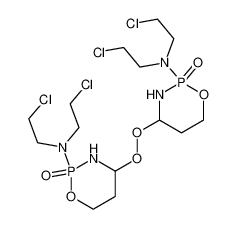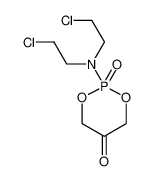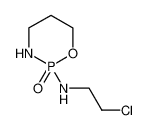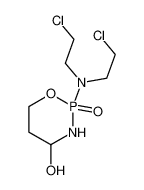1.Identification
1.1 GHS Product identifier
| Product name | cyclophosphamide |
|---|
1.2 Other means of identification
| Product number | - |
|---|---|
| Other names | ASTA |
1.3 Recommended use of the chemical and restrictions on use
| Identified uses | For industry use only. |
|---|---|
| Uses advised against | no data available |
1.4 Supplier's details
| Company | MOLBASE (Shanghai) Biotechnology Co., Ltd. |
|---|---|
| Address | Floor 4 & 5, Building 12, No. 1001 North Qinzhou Road, Xuhui District, Shanghai, China |
| Telephone | +86(21)64956998 |
| Fax | +86(21)54365166 |
1.5 Emergency phone number
| Emergency phone number | +86-400-6021-666 |
|---|---|
| Service hours | Monday to Friday, 9am-5pm (Standard time zone: UTC/GMT +8 hours). |
2.Hazard identification
2.1 Classification of the substance or mixture
Acute toxicity - Oral, Category 3
Germ cell mutagenicity, Category 1B
Carcinogenicity, Category 1B
Reproductive toxicity, Category 1A
2.2 GHS label elements, including precautionary statements
| Pictogram(s) |   |
|---|---|
| Signal word | Danger |
| Hazard statement(s) | H301 Toxic if swallowed H340 May cause genetic defects H350 May cause cancer H360 May damage fertility or the unborn child |
| Precautionary statement(s) | |
| Prevention | P264 Wash ... thoroughly after handling. P270 Do not eat, drink or smoke when using this product. P201 Obtain special instructions before use. P202 Do not handle until all safety precautions have been read and understood. P280 Wear protective gloves/protective clothing/eye protection/face protection. |
| Response | P301+P310 IF SWALLOWED: Immediately call a POISON CENTER/doctor/… P321 Specific treatment (see ... on this label). P330 Rinse mouth. P308+P313 IF exposed or concerned: Get medical advice/ attention. |
| Storage | P405 Store locked up. |
| Disposal | P501 Dispose of contents/container to ... |
2.3 Other hazards which do not result in classification
none
3.Composition/information on ingredients
3.1 Substances
| Chemical name | Common names and synonyms | CAS number | EC number | Concentration |
|---|---|---|---|---|
| cyclophosphamide | cyclophosphamide | 50-18-0 | none | 100% |
4.First-aid measures
4.1 Description of necessary first-aid measures
General advice
Consult a physician. Show this safety data sheet to the doctor in attendance.
If inhaled
Fresh air, rest. Refer for medical attention.
In case of skin contact
Remove contaminated clothes. Rinse skin with plenty of water or shower. Refer for medical attention .
In case of eye contact
First rinse with plenty of water for several minutes (remove contact lenses if easily possible), then refer for medical attention.
If swallowed
Rinse mouth. Induce vomiting (ONLY IN CONSCIOUS PERSONS!). Refer for medical attention .
4.2 Most important symptoms/effects, acute and delayed
SYMPTOMS: Symptoms of exposure to this compound may include nausea, vomiting, leukopenia, thrombocytopenia, alopecia and anorexia. Other symptoms may include pigmentation of the skin, oral mucosal ulcerations and sterile hemorrhagic cystitis. It can cause non-specific dermatitis, pigmentation of the nails, regrowth of hair, anemia, hematuria, fibrosis of the ovaries, gonadal suppression resulting in amenorrhea or azoospermia, hemorrhagic colitis and jaundice. It can also cause damage to the hair follicles, dizziness of short duration, transverse ridging of the nails and hepatic toxicity. Secondary neoplasia and nephrotoxicity have been reported. Other symptoms may include irritation of the skin, gastrointestinal disturbances and hepatic dysfunction. High doses over a prolonged period can cause interstitial pulmonary fibrosis. Other symptoms of exposure may include granulocytopenia, myocardial damage, interstitial pneumonia and hypoplasia of all elements of bone marrow. It has been known to cause blurred vision, pulmonary fibrosis, cardiomyopathy and sterility. Fetal abnormalities can occur if ingested while pregnant. Eye contact can cause transient blurring of vision, dry eye syndrome, viral and other keratitis and severe keratoconjunctivitis associated with graft-versus-host disease leading to scarring of the corneas. It may also cause lymphocytopenia. ACUTE/CHRONIC HAZARDS: This compound is a skin irritant. When heated to decomposition it emits highly toxic fumes of POx, NOx and chloride ion.
4.3 Indication of immediate medical attention and special treatment needed, if necessary
Basic treatment: Establish a patent airway. Suction if necessary. Watch for signs of respiratory insufficiency and assist ventilations if needed. Administer oxygen by nonrebreather mask at 10 to 15 L/min. Monitor for pulmonary edema and treat if necessary ... . Monitor for shock and treat if necessary ... . Anticipate seizures and treat if necessary ... . For eye contamination, flush eyes immediately with water. Irrigate each eye continuously with normal saline during transport ... . Do not use emetics. For ingestion, rinse mouth and administer 5 ml/kg up to 200 ml of water for dilution if the patient can swallow, has a strong gag reflex, and does not drool ... . Cover skin burns with dry sterile dressings after decontamination ... . /Poison A and B/
5.Fire-fighting measures
5.1 Extinguishing media
Suitable extinguishing media
Fires involving this material can be controlled with a dry chemical, carbon dioxide or Halon extinguisher.
5.2 Specific hazards arising from the chemical
Flash point data for this chemical are not available; however, it is probably combustible.
5.3 Special protective actions for fire-fighters
Wear self-contained breathing apparatus for firefighting if necessary.
6.Accidental release measures
6.1 Personal precautions, protective equipment and emergency procedures
Use personal protective equipment. Avoid dust formation. Avoid breathing vapours, mist or gas. Ensure adequate ventilation. Evacuate personnel to safe areas. Avoid breathing dust. For personal protection see section 8.
6.2 Environmental precautions
Consult an expert! Personal protection: particulate filter respirator adapted to the airborne concentration of the substance. Sweep spilled substance into covered sealable containers. If appropriate, moisten first to prevent dusting. Carefully collect remainder. Then store and dispose of according to local regulations.
6.3 Methods and materials for containment and cleaning up
PRECAUTIONS FOR "CARCINOGENS": A high efficiency particulate arrestor (HEPA) or charcoal filters can be used to minimize amt of carcinogen in exhausted air ventilated safety cabinets, lab hoods, glove boxes or animal rooms ... Filter housing that is designed so that used filters can be transferred into plastic bag without contaminating maintenance staff is available commercially. Filters should be placed in plastic bags immediately after removal ... The plastic bag should be sealed immediately ... The sealed bag should be labelled properly ... Waste liquids ... should be placed or collected in proper containers for disposal. The lid should be secured & the bottles properly labelled. Once filled, bottles should be placed in plastic bag, so that outer surface ... is not contaminated ... The plastic bag should also be sealed & labelled. ... Broken glassware ... should be decontaminated by solvent extraction, by chemical destruction, or in specially designed incinerators. /Chemical Carcinogens/
7.Handling and storage
7.1 Precautions for safe handling
Avoid contact with skin and eyes. Avoid formation of dust and aerosols. Avoid exposure - obtain special instructions before use.Provide appropriate exhaust ventilation at places where dust is formed. For precautions see section 2.2.
7.2 Conditions for safe storage, including any incompatibilities
Separated from food and feedstuffs. See Chemical Dangers. Dry. Keep in the dark. Well closed.Cyclophosphamide should be preserved in tight containers, at a temperature between 2 & 32°C.
8.Exposure controls/personal protection
8.1 Control parameters
Occupational Exposure limit values
no data available
Biological limit values
no data available
8.2 Appropriate engineering controls
Handle in accordance with good industrial hygiene and safety practice. Wash hands before breaks and at the end of workday.
8.3 Individual protection measures, such as personal protective equipment (PPE)
Eye/face protection
Safety glasses with side-shields conforming to EN166. Use equipment for eye protection tested and approved under appropriate government standards such as NIOSH (US) or EN 166(EU).
Skin protection
Wear impervious clothing. The type of protective equipment must be selected according to the concentration and amount of the dangerous substance at the specific workplace. Handle with gloves. Gloves must be inspected prior to use. Use proper glove removal technique(without touching glove's outer surface) to avoid skin contact with this product. Dispose of contaminated gloves after use in accordance with applicable laws and good laboratory practices. Wash and dry hands. The selected protective gloves have to satisfy the specifications of EU Directive 89/686/EEC and the standard EN 374 derived from it.
Respiratory protection
Wear dust mask when handling large quantities.
Thermal hazards
no data available
9.Physical and chemical properties
| Physical state | white crystalline powder |
|---|---|
| Colour | LIQUEFIES ON LOSS OF ITS WATER OF CRYSTALLIZATION |
| Odour | Odorless |
| Melting point/ freezing point | 41-45ºC |
| Boiling point or initial boiling point and boiling range | 336.1ºC at 760 mmHg |
| Flammability | Combustible. Gives off irritating or toxic fumes (or gases) in a fire. |
| Lower and upper explosion limit / flammability limit | no data available |
| Flash point | 157.1ºC |
| Auto-ignition temperature | no data available |
| Decomposition temperature | no data available |
| pH | no data available |
| Kinematic viscosity | no data available |
| Solubility | 10 to 50 mg/mL at 22.78°C |
| Partition coefficient n-octanol/water (log value) | no data available |
| Vapour pressure | no data available |
| Density and/or relative density | 1.33 g/cm3 |
| Relative vapour density | no data available |
| Particle characteristics | no data available |
10.Stability and reactivity
10.1 Reactivity
no data available
10.2 Chemical stability
AQ SOLN KEEPS FOR A FEW HR @ ROOM TEMP, BUT HYDROLYSIS OCCURS ABOVE 30 DEG C, REMOVES CHLORINE ATOMS; DARKENS ON EXPOSURE TO LIGHT /MONOHYDRATE/
10.3 Possibility of hazardous reactions
CYCLOPHOSPHAMIDE is sensitive to exposure to light (darkens). Also sensitive to oxidation. Aqueous solutions may be kept for a few hours at room temperature, but hydrolysis occurs at temperatures above 30°C. Solutions in DMSO, 95% ethanol or acetone are stable for 24 hours under normal lab conditions. Incompatible with benzyl alcohol. Undergoes both acid and base hydrolysis at extreme pHs
10.4 Conditions to avoid
no data available
10.5 Incompatible materials
/It was/ reported that immersion of a needle with an aluminum component in cyclophosphamide 20 mg/ml resulted in a slight darkening of the aluminum & gas production after a few days at 24°C with protection from light.
10.6 Hazardous decomposition products
When heated to decomposition it emits highly toxic fumes of /phosphorus oxides, nitrogen oxides, & hydrogen chloride/.
11.Toxicological information
Acute toxicity
- Oral: LD50 Rat oral 160 mg/kg
- Inhalation: no data available
- Dermal: no data available
Skin corrosion/irritation
no data available
Serious eye damage/irritation
no data available
Respiratory or skin sensitization
no data available
Germ cell mutagenicity
no data available
Carcinogenicity
Classification of carcinogenicity: 1) evidence in humans: sufficient; 2) evidence in animals: sufficient. Overall summary evaluation of carcinogenic risk to humans is Group 1: The agent is carcinogenic to humans. /From table/
Reproductive toxicity
no data available
STOT-single exposure
no data available
STOT-repeated exposure
no data available
Aspiration hazard
no data available
12.Ecological information
12.1 Toxicity
- Toxicity to fish: no data available
- Toxicity to daphnia and other aquatic invertebrates: no data available
- Toxicity to algae: no data available
- Toxicity to microorganisms: no data available
12.2 Persistence and degradability
AEROBIC: Cyclophosphamide has been shown to be non-biodegradable in a laboratory-scale sewage treatment studies(1-3). During 29 days of 10 ug/l compound addition, a mean effluent recovery of 83% was established(2). Cyclophosphamide, present at 160 mg/l, indicated no DOC elimination in four weeks using an activated sludge inoculum at 0.2 g/l and the Zahn-Wellens test(2). The compound is confirmed to be non-biodegradable according to the OECD confirmatory test using both single compound and compound mixtures run from a period of 10-14 days at concentrations ranging from 150 to 750 mg/l and that employs a sewage sludge inoculum(3).
12.3 Bioaccumulative potential
An estimated BCF of 3 was calculated for cyclophosphamide(SRC), using a log Kow of 0.63(1) and a regression-derived equation(2). According to a classification scheme(3), this BCF suggests the potential for bioconcentration in aquatic organisms is low(SRC).
12.4 Mobility in soil
The Koc of cyclophosphamide is estimated as 52(SRC), using a log Kow of 0.63(1) and a regression-derived equation(2). According to a classification scheme(3), this estimated Koc value suggests that cyclophosphamide is expected to have high mobility in soil.
12.5 Other adverse effects
no data available
13.Disposal considerations
13.1 Disposal methods
Product
The material can be disposed of by removal to a licensed chemical destruction plant or by controlled incineration with flue gas scrubbing. Do not contaminate water, foodstuffs, feed or seed by storage or disposal. Do not discharge to sewer systems.
Contaminated packaging
Containers can be triply rinsed (or equivalent) and offered for recycling or reconditioning. Alternatively, the packaging can be punctured to make it unusable for other purposes and then be disposed of in a sanitary landfill. Controlled incineration with flue gas scrubbing is possible for combustible packaging materials.
14.Transport information
14.1 UN Number
| ADR/RID: UN1851 | IMDG: UN1851 | IATA: UN1851 |
14.2 UN Proper Shipping Name
| ADR/RID: MEDICINE, LIQUID, TOXIC, N.O.S. |
| IMDG: MEDICINE, LIQUID, TOXIC, N.O.S. |
| IATA: MEDICINE, LIQUID, TOXIC, N.O.S. |
14.3 Transport hazard class(es)
| ADR/RID: 6.1(b) | IMDG: 6.1(b) | IATA: 6.1(b) |
14.4 Packing group, if applicable
| ADR/RID: III | IMDG: III | IATA: III |
14.5 Environmental hazards
| ADR/RID: no | IMDG: no | IATA: no |
14.6 Special precautions for user
no data available
14.7 Transport in bulk according to Annex II of MARPOL 73/78 and the IBC Code
no data available
15.Regulatory information
15.1 Safety, health and environmental regulations specific for the product in question
| Chemical name | Common names and synonyms | CAS number | EC number |
|---|---|---|---|
| cyclophosphamide | cyclophosphamide | 50-18-0 | none |
| European Inventory of Existing Commercial Chemical Substances (EINECS) | Listed. | ||
| EC Inventory | Listed. | ||
| United States Toxic Substances Control Act (TSCA) Inventory | Not Listed. | ||
| China Catalog of Hazardous chemicals 2015 | Not Listed. | ||
| New Zealand Inventory of Chemicals (NZIoC) | Not Listed. | ||
| Philippines Inventory of Chemicals and Chemical Substances (PICCS) | Not Listed. | ||
| Vietnam National Chemical Inventory | Not Listed. | ||
| Chinese Chemical Inventory of Existing Chemical Substances (China IECSC) | Not Listed. | ||
16.Other information
Information on revision
| Creation Date | Aug 19, 2017 |
|---|---|
| Revision Date | Aug 19, 2017 |
Abbreviations and acronyms
- CAS: Chemical Abstracts Service
- ADR: European Agreement concerning the International Carriage of Dangerous Goods by Road
- RID: Regulation concerning the International Carriage of Dangerous Goods by Rail
- IMDG: International Maritime Dangerous Goods
- IATA: International Air Transportation Association
- TWA: Time Weighted Average
- STEL: Short term exposure limit
- LC50: Lethal Concentration 50%
- LD50: Lethal Dose 50%
- EC50: Effective Concentration 50%
References
- IPCS - The International Chemical Safety Cards (ICSC), website: http://www.ilo.org/dyn/icsc/showcard.home
- HSDB - Hazardous Substances Data Bank, website: https://toxnet.nlm.nih.gov/newtoxnet/hsdb.htm
- IARC - International Agency for Research on Cancer, website: http://www.iarc.fr/
- eChemPortal - The Global Portal to Information on Chemical Substances by OECD, website: http://www.echemportal.org/echemportal/index?pageID=0&request_locale=en
- CAMEO Chemicals, website: http://cameochemicals.noaa.gov/search/simple
- ChemIDplus, website: http://chem.sis.nlm.nih.gov/chemidplus/chemidlite.jsp
- ERG - Emergency Response Guidebook by U.S. Department of Transportation, website: http://www.phmsa.dot.gov/hazmat/library/erg
- Germany GESTIS-database on hazard substance, website: http://www.dguv.de/ifa/gestis/gestis-stoffdatenbank/index-2.jsp
- ECHA - European Chemicals Agency, website: https://echa.europa.eu/

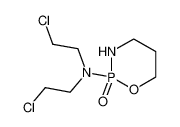



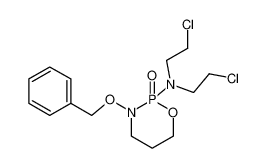


![195966-75-7 spectrum, (2-Oxo-2λ5-[1,3,2]oxazaphosphinan-2-yl)-bis-(2-trimethylsilanyloxy-ethyl)-amine](http://saasimg.molbase.net/mol_command/c18303521cbd4448b39b5b456ea74e68.png)
